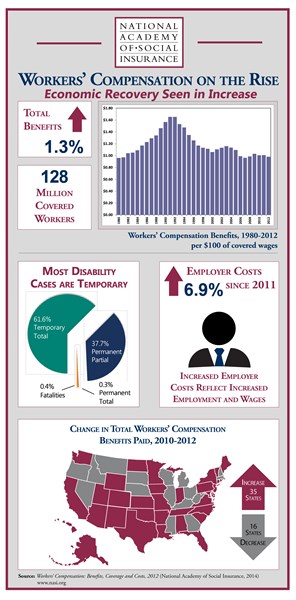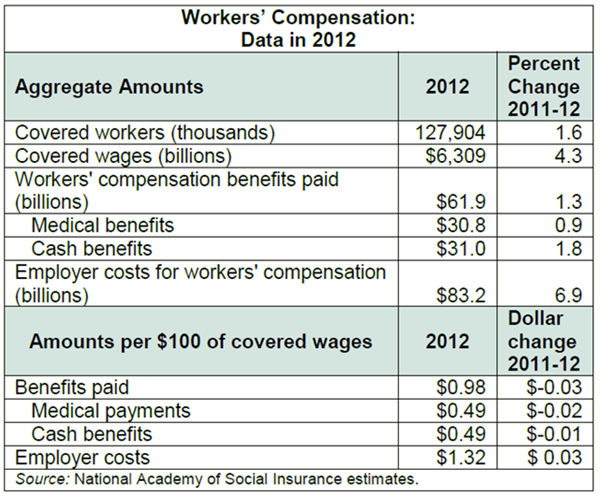WASHINGTON, DC, Aug. 26, 2014 (GLOBE NEWSWIRE) -- Workers' compensation benefits rose by 1.3 percent to $61.9 billion in 2012, while employer costs rose by 6.9 percent to $83.2 billion, according to a report released today by the National Academy of Social Insurance (the Academy).
"This growth in workers' compensation spending reflects rising employment and earnings as the economic recovery continues," said Marjorie Baldwin, chair of the Academy's Workers' Compensation Data Panel and Professor of Economics in the W. P. Carey School of Business at Arizona State University.
Despite the uptick in total benefits and costs in 2012, workers' compensation benefits and costs per $100 of covered payroll have been lower in 2007 to 2012 than at any time over the last three decades. In 2012, benefits were $0.98 per $100 of covered payroll while employer costs were $1.32 per $100 of covered payroll.
"In comparing trends over time it is useful to consider benefits and costs as a share of covered payroll, which accounts for changes in employment and earnings," said Eric Nordman, a member of the Academy's data panel and Director of the Regulatory Services Division and the Center for Insurance Policy and Research at the National Association of Insurance Commissioners.
Workers' compensation was the first social insurance program in the United States. In 2012, workers' compensation coverage was 100 years old in 15 states. Workers' compensation provides medical benefits, paid to the providers of health care for injured workers, and cash benefits, paid to workers during periods of injury-related work absence. Over the last 30 years, medical benefits have accounted for an increasing share of total benefits, from 33% in 1984 to nearly 50% in 2012. Medical benefits were $30.8 billion (49.8% of the total) and cash benefits were $31.0 billion in 2012.
The new report shows state-by-state changes in coverage, benefits, and employer costs over the last five years. The state-level results show that, between 2010 and 2012:
- The number of covered workers and amount of covered wages increased in all jurisdictions (50 states and the District of Columbia).
- Benefits per $100 of covered payroll decreased in 39 jurisdictions.
- Employers' costs per $100 of covered payroll increased in 42 jurisdictions.
- In 2012, medical benefits exceeded cash benefits in 33 jurisdictions.
The Academy's report, Workers' Compensation: Benefits, Coverage, and Costs, 2012, is the 17th in an annual series. The report provides the only comprehensive data on workers' compensation benefits, coverage and employer costs for the nation, the states, the District of Columbia and federal programs.
NOTE TO REPORTERS AND EDITORS: The full report is available from the Academy's website at www.nasi.org. For a copy of the printed report, media can contact Jill Braunstein at (202) 452-8097 or at jbraunstein@nasi.org. All others should contact Ishita Sengupta at isengupta@nasi.org.
| EXPERTS TO CONTACT: |
| Ishita Sengupta |
| National Academy of Social Insurance |
| (202) 243-7280 isengupta@nasi.org |
| Marjorie Baldwin |
| Arizona State University |
| (480) 577-2771 |
| marjorie.baldwin@asu.edu |
| Eric Nordman |
| National Association of Insurance Commissioners |
| (816) 783-8005 |
| enordman@naic.org |
| Virginia Reno |
| National Academy of Social Insurance |
| (202) 452-8097 |
| vreno@nasi.org |
Photos accompanying this release are available at:

